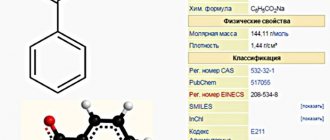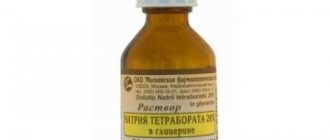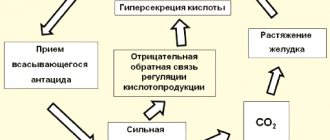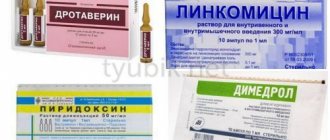Pharmacodynamics and pharmacokinetics
Sodium thiopental acts as a hypnotic and narcotic. It is used primarily for intravenous anesthesia . The drug also has some muscle relaxant and analgesic effects.
On the postsynaptic membrane of brain neurons, the drug prolongs the period of opening of γ-aminobutyric acid-dependent channels . It inhibits the excitatory effect of amino acids , prevents the conduction and spread of convulsive impulses throughout the brain, has anticonvulsant activity, and increases the threshold of neuronal excitability .
The drug promotes muscle relaxation by blocking polysynaptic reflexes and inhibiting conduction along interneurons of the spinal cord. In addition, the drug reduces metabolic processes in the brain and the brain's utilization of oxygen and glucose.
Acts as hypnotic , helps change the structure of sleep and speeds up falling asleep. Reduces the sensitivity of the respiratory center to carbon dioxide and depresses breathing. Sodium thiopental acts as cardiodepressant : it reduces stroke volume , blood pressure and cardiac output . The medicine increases the capacity of the venous system , the glomerular filtration and reduces hepatic blood flow .
Has a stimulating effect on the vagus nerve . May provoke laryngospasm and mucus production.
The effect of the drug becomes noticeable 40 seconds after intravenous administration , and after rectal administration - after 8-10 minutes. The effect of the drug is short-lived. After a single injection, anesthesia lasts 20-25 minutes. Awakening occurs without residual drowsiness .
With general anesthesia , there is a decrease or complete disappearance of tendon and corneal reflexes , a stationary or “floating” position of the eyeballs, a decrease in the depth of breathing, relaxation of the pharyngeal muscles, retraction of the tongue, and a decrease in blood pressure .
The analgesic effect ceases when the patient awakens. In case of repeated administration, the effect of the drug is prolonged.
When administered intravenously, the drug quickly reaches the brain, kidneys, adipose tissue, skeletal muscle and liver. The degree of binding to plasma is about 83%. The drug is able to penetrate the placental barrier and enter breast milk. It is broken down primarily in the liver. In this case, inactive metabolites . Some of it is inactivated in the brain and kidneys. The half-life of this drug is approximately 11 hours. Excreted mainly through the kidneys.
How does dependence on barbiturates develop?
Habituation and drug dependence form quite quickly. In just a few weeks of systematic use, not only a physical, but also a mental craving for the drug arises. However, addiction to the standard dose soon sets in; drug addicts increase it to obtain euphoria. A person without another pill becomes nervous and irritable, emotionally unstable, aggressive, and suffers from insomnia. However, in addition to increasing the dosage, drug addicts in some cases change the method of introducing the drug into the body. Often, oral administration is replaced by intravenous administration, which significantly increases intoxication and the risk of severe health complications, including death.
If the next dose is missing, the addict goes into withdrawal. Withdrawal syndrome is very difficult for the addict, both mentally and physically. He cannot sleep properly, he is tormented by nightmares, depression, and suicidal thoughts. Treatment for sodium pentobarbital addiction takes a long time, often lasting 6-12 months.
People quite often come to the Center for Healthy Youth with poisoning from this drug and similar barbiturates. The overdose mortality rate is about 3%.
Anonymous 24 hours a day Activity is licensed Patient accompaniment
Full range of narcology services:
- tests
- drug testing
- detox
- encoding
- psychiatry
- binder
- withdrawal symptoms
8+7
Indications for use
The drug is used intravenously for anesthesia during short-term operations. In addition, among its indications are: status epilepticus , grand mal seizures, increased intracranial pressure . It is also used to prevent hypoxia during TBI and as an introductory and basic anesthesia in the case of balanced anesthesia with the use of muscle relaxants and analgesics .
Contraindications
This drug should not be used in case of hypersensitivity to its components, status asthmaticus , disorders of myocardial contractile function , shock and collaptoid conditions , myxedema , fever , porphyria , bronchial asthma , / kidney dysfunction , severe anemia , myasthenia , diabetes mellitus , severe exhaustion, collapse , Addison's disease , inflammatory diseases of the nasopharynx and pregnancy .
Side effects
The medicine may cause chills , arrhythmia , difficulty or complete stoppage of breathing, nausea, rectal irritation, drowsiness , rectal bleeding hypotension , laryngospasm , bronchospasm , vomiting, headache and heart failure . In addition, when using it, the following allergic reactions : urticaria , itching , skin rashes, anaphylactic shock .
Providing emergency assistance
Even a minor overdose is a serious reason to call an emergency doctor at home. It is important to make a call in time, as the victim’s condition may worsen. The primary task of doctors in case of intoxication is to remove toxins from the human body as quickly as possible. If the victim is conscious, the stomach is cleansed, it is necessary to give him as much water as possible, adsorbents and induce vomiting so that toxic substances stop being absorbed into the blood through the gastrointestinal tract. If there is paralysis of the respiratory system, it is worth giving the dependent person artificial respiration until the doctor arrives.
It is worth entrusting all other rehabilitation and medication measures to doctors. Specialists will examine the patient and, based on express diagnostics, will be able to select symptomatic medications, in particular, diuretics.
Instructions for use of Sodium Thiopental (Method and dosage)
The medicine should be injected into the vein slowly. Speed approximately 1 ml/min. Otherwise, the likelihood of collapse .
Instructions for use of Thiopental Sodium indicate that, as a rule, a 2-2.5% solution of the drug is used anesthesia Children, elderly patients and weakened patients are administered a 1% solution. It is prepared immediately before use using pure water for injection , otherwise after a few hours the medicine will no longer be suitable for administration.
To prepare a 5% solution, add 20 ml of water for injection . A 1.25% solution is prepared by dissolving 0.5 g of Sodium Thiopental in 40 ml of water. The solvent used is purified water, 5% glucose solution or physiological sodium chloride solution. The solvent is drawn into a syringe and poured into an ampoule with the drug, where everything is mixed until the medicine is completely dissolved. The finished solution must be completely transparent, otherwise it cannot be used.
For induction of anesthesia, 20-30 ml of a 2% solution is injected. The same dosage is administered when using Sodium Thiopental alone for minor short-term operations. As a rule, 2-3 ml of solution is first injected , and then the remaining amount is injected after 20-30 seconds.
A 5% solution is slowly injected in a dosage of 4-6 ml into the cubital vein . If sleep does not occur, is injected . In most cases, no more than 10-12 ml of the drug is needed anesthesia The dosage is adjusted depending on the effect of the drug.
To relieve seizures, the drug is administered intravenously at a dose of 75-125 mg for 10 minutes. If seizures develop in the case of local anesthesia , administration of 125-250 mg for 10 minutes is indicated.
In case of hypoxia , the drug is administered at a dosage of 1.5-3.5 mg/kg 60 seconds before temporary cessation of blood circulation.
Patients with renal dysfunction are prescribed 75% of the average dosage.
For children, the drug can be administered rectally . For this, a 5% solution is used. Dosage – 0.04-0.05 g per 1 year of the patient’s life (age from 3 to 7 years).
In children, the medicine is administered intravenously Dose – 3-5 mg/kg. Before inhalation anesthesia without previous premedication the following dosages are indicated:
- 1-12 years – 5-6 mg/kg is administered;
- 1-12 months – 5-8 mg/kg is administered;
- up to 1 month – 3-4 mg/kg is administered.
For general anesthesia, children weighing 30-50 kg are administered 4-5 mg/kg. Maintenance dosage is from 25 to 50 mg.
A single dosage for adult patients should not exceed 1 g.
In order to avoid respiratory depression, it is advisable to give the patient to breathe a mixture of oxygen and carbon dioxide during anesthesia . In case of respiratory and circulatory disorders, administration of Cordiamin , caffeine, Corazol intravenously or intramuscularly .
Interesting Facts
In America, this drug was used to execute a death sentence, but the pharmaceutical company that produced this drug refused to supply it to prisons, which led to its replacement with analogues. Today, pentobarbital is used in countries where euthanasia (voluntary death) is allowed, as well as for “euthanizing” animals in veterinary medicine.
It was Nembutal that was used by the love of her life and Mayakovsky’s muse, Lilya Brik, for a successful suicide attempt at the age of 87.
In our country, sodium pentobarbital is included in List II of narcotic drugs, psychotropic substances and their precursors, its circulation is strictly monitored by the responsible authorities. This substance is used by drug addicts for recreational purposes (for the purpose of drug intoxication), as well as by people attempting suicide.
Pentobarbital should not be confused with phenobarbital, which is an antiepileptic drug, but is also a barbiturate.
- You can't convince me to get treatment
? - We will help you with motivation for treatment. As a rule, it is difficult for loved ones to persuade or force an addict to undergo treatment. World experts have developed EFFECTIVE motivation schemes, using which you can lead an addict to the decision to seek help. 8
Overdose
In some US states, an overdose of Sodium Thiopental is used for execution.
Currently, the following symptoms of overdose with this drug are known: depression of the nervous system, muscle hyperreactivity , laryngospasm , decreased blood pressure , decreased total peripheral vascular resistance , post-anesthesia delirium , convulsions, depression of the respiratory center, water-electrolyte disturbances, tachycardia . The use of this drug in doses significantly higher than normal leads to edema , cardiac arrest and circulatory collapse .
The antidote is Bemegrid . In case of collapse and a significant decrease in pressure plasma-substituting solutions , the use of drugs with a positive inotropic effect and/or vasopressor are prescribed . In case of respiratory arrest, artificial ventilation , 100% oxygen is indicated. In case of laryngospasm, the patient is given muscle relaxants and 100% oxygen under pressure. For convulsions, intravenous administration of Diazepam . If this does not help, use mechanical ventilation and muscle relaxants .
Effect of pentobarbital
Etaminal sodium helps eliminate cramps, promotes rapid sleep, and helps get rid of insomnia. If you take the drug in therapeutic doses, without exceeding the daily dosage recommended by your doctor (usually 0.1 g), no side effects will occur. However, with an overdose, a feeling of calm, lightness, relaxation, tranquility arises, problems dissolve, and confidence in the future arises. It is this narcotic effect that drug addicts achieve by using the medicine for other purposes in higher dosages. The drug gives the addict euphoria, calm, hallucinations (visual, auditory, tactile) and visions.
Interaction
The administration of Sodium Thiopental for anesthesia is usually combined with the use of muscle relaxants . This drug is contraindicated to be mixed with Ditiline , Diprazine , Pentamin , Aminazine .
Interaction with ethanol and drugs that depress the nervous system causes a mutual enhancement of the effects of the drugs. Thus, this can provoke significant depression of the central nervous system, increased hypotensive effect, difficulty breathing and increased hypnotic effects.
When combined with Magnesium Sulfate, CNS depression increases. The hypotensive effect is enhanced by interaction with antihypertensive drugs. Concomitant use with Methotrexate increases its toxic effect.
Thiopental Sodium reduces the effect of indirect anticoagulants , contraceptives , Griseofulvin , GCS . It also increases the effects of medications that cause hypothermia .
Combination with Ketamine in blood pressure and depression of the respiratory center more likely It also leads to a prolongation of the recovery time of body functions after the body recovers from general anesthesia .
The effect of Sodium Thiopental is enhanced by drugs that inhibit tubular secretion and H1-histamine blockers . And some antidepressants , Aminophylline and analeptics , on the contrary, weaken it.
Interaction with Diazoxide increases the likelihood of a pronounced decrease in blood pressure .
The drug is not combined with antibiotics , narcotic analgesics , Epinephrine , Dipyridamole , Ketamine , Scopolamine , Ephedrine , Ascorbic acid , Chlorpromazine , Atropine , Tubocurarine chloride (cannot be mixed in one syringe).





